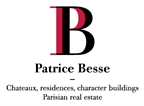An impressive 19th century chateau in a park of almost 2 ha on the banks of the Seine, between Le Havre and Rouen - ref 148099
An impressive 19th century chateau in a park of almost 2 ha on the banks of the Seine, between Le Havre and Rouen.
In the Boucles de la Seine Normande Regional Nature Park and at the start of the "Route des Fruits", the property is situated 20 minutes from Rouen railway station, offering frequent train services connecting to Paris in only 1h30. The capital can also be reached by car via the A13 in less than two hours. The Alabaster Coast with its 140 km of high chalk cliffs and valleys with beaches is less than one hour away.
A small, dynamic town on the banks of the Seine, 5 km from the property, offers local shops and amenities and links to the Historical Route of Norman Abbeys. As part of the Rouen metropolitan area, the town has all the services and infrastructures of a large conurbation.
From the main road that winds its way along the river between forests and marshes, two entrances provide access to the property and its 2 ha of wooded parklands. One leads to a parking area as well as an outbuilding on the edge of a pond. The other, marked by a wrought iron gate flanked by two brick pillars, leads to a second outbuilding and to the steps up to the entrance of the chateau. This is surrounded by large lawned areas enclosed by gates and walls. To the rear of the south-west facing residence, a striking view takes in the Seine and its surrounding countryside.
The chateauComprising a four-level main building flanked by two wings, the chateau abounds in architectural details. Dressed stone corner quoins and window frames enhance the red brick facades. The different levels are separated by imposing stringcourses. The openings on the ground floor are topped by semi-circular or segmental arches. On the first floor, they are protected by stone or wrought iron balustrades.
The rear facade of the chateau overlooks the Seine. An impressive three-sided avant-corps, crowned by a stone balustrade, completes the central section of the building. A glass and wrought iron canopy tops three tall French windows. These open onto a terrace where two flights of steps lead down to the gravel courtyard. The recessed wings reinforce the impression of an arc. The front façade of the chateau is divided into three bays. A flight of steps leads to the ground floor entrance, which is also topped by a glass and wrought iron canopy. The tall four-pitched slate roofs have dormers, those of the wings are topped by oeil-de-boeuf windows. The variety of styles adds to the magnificence of the chateau, with gambrel and hip roofs for the main building, and a turret roof topping the avant-corps.
The ground floor
The double glass door opens onto a hallway laid with coloured cement tiles featuring floral motifs. It serves three sitting rooms in a row. On one side, suspended stairs turning to the left lead to the two upper floors. Directly opposite, a double door opens into the kitchen. From there, a staircase leads down to the basement. The central sitting room forms a three-sided avant-corps, generously lit by large arched windows. The three sitting rooms feature herringbone parquet flooring and wainscoting. A white marble fireplace topped by an overmantel mirror with gilded wood frame adorns the semi-circular wall of one of these rooms. Each of the two wings flanking the central section contains a spacious and luminous full-width drawing room. The first has a herringbone parquet floor, wood panelling decorated with painted scenes and ceiling cornices. The other is floored with flagstones and has soberly moulded wainscoting, creating a more contemporary atmosphere. Facing south-west and abutting one of the wings, an iron and glass conservatory, with a wide view of the Seine, forms a transition between the chateau and its garden. A place of companionship where one can share a cup of tea or a place of retreat to simply ...


